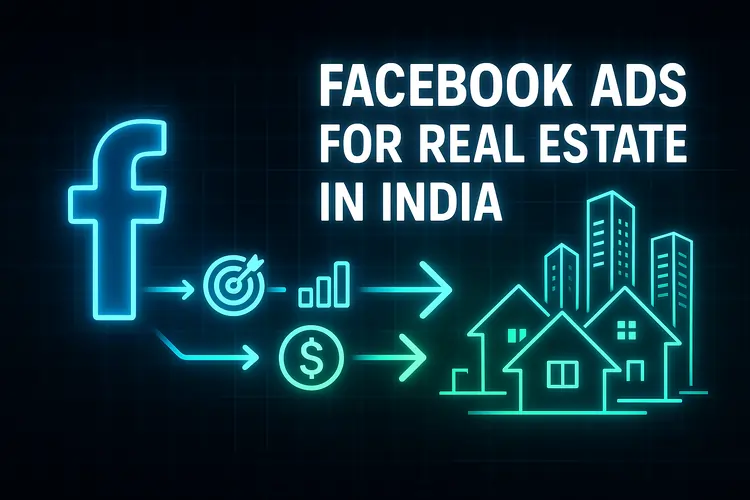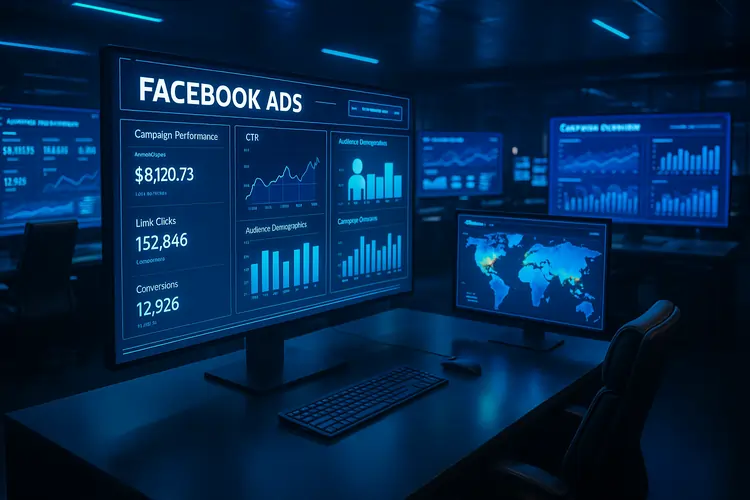Running Facebook Ads in India in 2025 is not just about boosting a post and hoping for sales. It’s about understanding how Meta’s system works, where your audience spends time, and how to get the maximum return for every Rupee you invest.
If you are new to Facebook Ads, this guide will walk you through everything — from setting up your first campaign to scaling it profitably. No jargon. No fluff. Just clear, India-specific strategies that actually work in 2025.
We run Facebook and Instagram ad campaigns daily for our clients across India. As a Google Partner PPC agency, we’ve seen what works, what fails, and how to avoid burning through your budget.
Whether you are a local business owner, an e-commerce seller, or someone exploring online business ideas in India, this guide will help you master Facebook Ads faster and smarter.
Table of Contents – Facebook Ads in India 2025
- Why Facebook Ads Still Work in India in 2025
- How Facebook Ads Have Changed in 2025
- Understanding Facebook Ad Objectives
- Setting Up Facebook Business Manager
- Installing Facebook Pixel & Conversions API
- Understanding Facebook Ad Account Structure
- Choosing the Right Targeting in India (2025 Edition)
- Ad Creative Strategies That Work in India
- Budget & Bidding Strategies
- Tracking & Measuring Success
- Common Beginner Mistakes to Avoid
- Advanced Scaling Tips
- India-Specific Facebook Ads Case Studies
- Free Resources for Facebook Ads Learners
- Conclusion & Next Steps
Why Facebook Ads Still Work in India in 2025
Many people think Facebook Ads in India are no longer effective because competition is high. But the truth is — Facebook and Instagram together still have one of the largest active user bases in India. 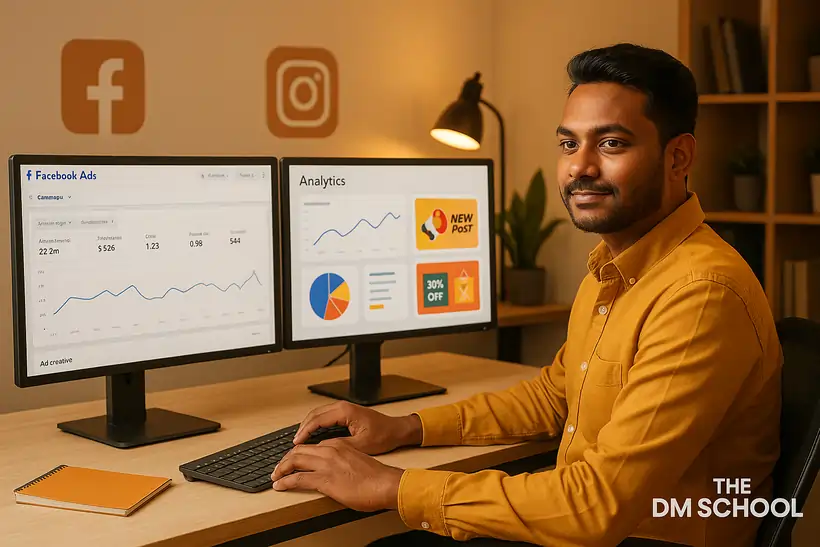
Whether it’s your college student scrolling Reels or your neighbourhood business owner checking updates, your audience is here.
In 2025, Meta’s ad placements go far beyond the Facebook news feed. You can reach people on Instagram Stories, Reels, Marketplace, Messenger, and even third-party apps through the Audience Network. This makes Facebook Ads a complete ecosystem for getting attention and driving action.
Our campaigns prove this every day. From local shop owners to large e-commerce brands, we’ve seen Facebook Ads deliver leads under ₹50 and sales with 5x ROAS when done right. The key is knowing your audience and matching your ad message with their current needs. If you’re exploring business ideas in India, Facebook Ads should be one of your first marketing tools.
In short — Facebook Ads are not dead. They’re evolving. And those who adapt to its new AI-driven targeting and creative-first approach will continue to win in 2025 and beyond.
How Facebook Ads Have Changed in 2025
If you last ran Facebook Ads in India a year or two ago, things have shifted. The way Meta delivers ads, tracks results, and optimizes campaigns has changed — and beginners need to know this before spending their first Rupee.
1. AI-Powered Targeting is the Default
Facebook’s Advantage+ and broad targeting features are now core. Instead of manually selecting dozens of interests, AI learns from your data and optimizes who sees your ad. This means better reach but also requires stronger creatives and clear objectives.
2. Tracking Has Evolved with Privacy Updates
After iOS privacy changes, relying on the Facebook Pixel alone is risky. The Conversions API (CAPI) is now a must if you want accurate data. Without it, your reports may miss 20-30% of actual conversions — which can kill your scaling decisions.
3. Creative is More Important Than Ever
Ad fatigue hits fast. In 2025, short videos (especially Reels ads) and user-generated content (UGC) style ads outperform generic stock creatives. Your ability to test 3–5 variations weekly can make or break your ROI.
4. Rising Costs — But Still Profitable
Yes, CPMs have gone up. But in our campaigns, strong creative and proper targeting still deliver profitable results. This is why more people are learning Facebook Ads to run for their own online businesses in India instead of outsourcing immediately.
Bottom line: Facebook Ads in 2025 are less about “hacks” and more about mastering fundamentals — targeting, creative, tracking, and consistent testing.
Understanding Facebook Ad Objectives in 2025
Meta has completely restructured how you set up Facebook Ads in India. The old long list of campaign objectives is gone. In 2025, Facebook uses the ODAX (Outcome-Driven Ad Experiences) system — only six streamlined objectives remain.
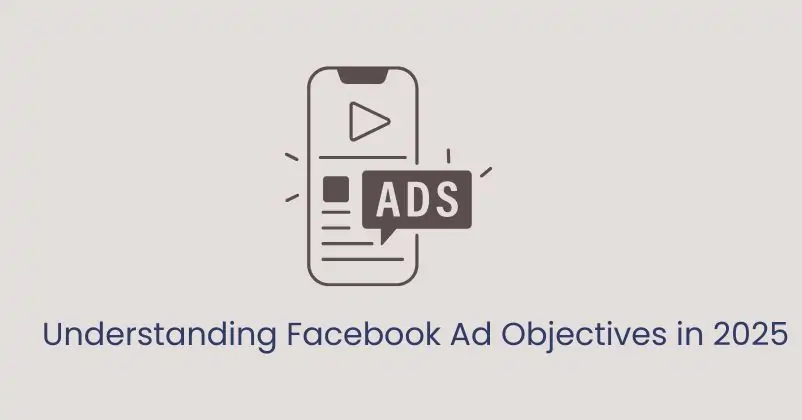
This change is not just cosmetic. Your chosen objective tells Facebook’s AI exactly what you want, and the algorithm will go after people most likely to take that action. Pick wrong, and you’ll spend your budget attracting the wrong crowd.
The 6 Facebook Ad Objectives in 2025:
- Awareness – Perfect for putting your brand in front of as many relevant people as possible. Great for launches, events, or creating top-of-mind recall in your city.
- Traffic – Drives people to your website, blog, or landing page. Useful when you’re promoting offers or valuable content like our guide on making money in one hour.
- Engagement – Get more likes, comments, shares, video views, or messages. Ideal for warming up cold audiences before asking for a sale.
- Leads – Collect names, emails, and phone numbers using instant forms, Messenger, or your own website forms. Perfect for service businesses in India.
- Sales – The new home for Conversions and Catalog Sales. Facebook will find buyers, not just clickers — ideal for e-commerce or high-ticket services.
- App Promotion – Drive installs and engagement for your mobile app. Optimized for people most likely to download and use it.
Beginner Tip: If you’re just starting with Facebook Ads in India, begin with Traffic or Engagement to build an audience, then switch to Leads or Sales once your Pixel and Conversions API have enough data.
Remember — your objective is like your campaign’s GPS. Set it wrong, and no matter how good your ad looks, you’ll end up in the wrong destination.
Setting Up Facebook Business Manager
Before you can run Facebook Ads in India, you need a proper Business Manager (now called Meta Business Manager). This is your control hub — where you manage ad accounts, Pages, Pixels, payment methods, and team access in one place.
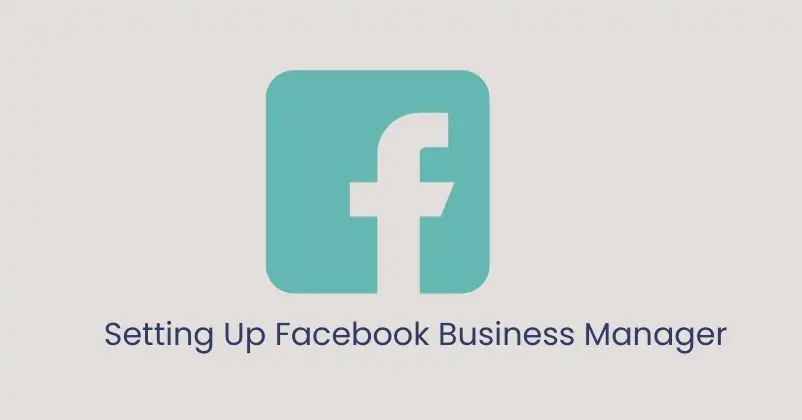
Many beginners skip this and run ads from their personal profiles. That’s a rookie mistake. Business Manager gives you more security, better tracking, and a professional setup — which matters when you start scaling.
Step 1: Create Your Business Manager Account
Go to business.facebook.com and click “Create Account.” Use your official business email. This keeps your ad account safe and separate from personal use.
Step 2: Add Your Facebook Page
If you already have a Page, connect it here. If not, create one — even if your business is just starting. Your ads will run from this Page, and it builds credibility with customers.
Step 3: Add an Ad Account
You can create a new ad account or request access to an existing one. Set your currency to INR so billing is clear and in Rupees.
Step 4: Add a Payment Method
In “Payment Settings,” add your credit/debit card or UPI. Keep at least two active payment methods to avoid sudden campaign pauses.
Step 5: Assign Roles & Permissions
If you have a team or work with agencies, assign them proper access. Don’t share your personal login — instead, give them role-based permissions inside Business Manager. At The DM School, this is exactly how we keep client accounts secure.
Once your Business Manager is set, you’re ready to connect your tracking tools — the Facebook Pixel and Conversions API — before launching your first campaign.
Installing Facebook Pixel & Conversions API
If you want your Facebook Ads in India to work in 2025, tracking is non-negotiable. Without it, you’re flying blind. You won’t know which ads bring sales, which audiences convert, or how to scale profitably.
![]()
Meta offers two main tracking tools — the Facebook Pixel and the Conversions API (CAPI). They work best together.
Facebook Pixel
A small piece of code you add to your website. It tracks user actions like page views, add-to-cart, and purchases. Pixel data tells Facebook which users are valuable so it can find more like them.
Conversions API (CAPI)
CAPI sends conversion data directly from your server to Facebook, bypassing browser tracking issues. This is crucial after iOS privacy updates and ad blockers — without it, you can lose 20–30% of conversion tracking.
How to Set Up Pixel & CAPI:
- Go to Events Manager in Business Manager.
- Create a new Pixel and follow the guided installation process.
- If you use WordPress, Shopify, or WooCommerce, use the official Facebook plugin or integration for one-click setup.
- Enable Conversions API in the same Events Manager screen. Most major platforms support it without coding.
Pro Tip: Test your setup using Facebook’s Event Testing tool. Make sure both browser and server events are firing. At The DM School, we never launch a campaign without double-checking this step.
Once Pixel and CAPI are live, every click, lead, and sale will be tracked accurately — giving Facebook the data it needs to optimize your campaigns and lower your cost per result.
Understanding Facebook Ad Account Structure
Before you spend a single Rupee on Facebook Ads in India, you need to understand how the system is structured. This is where most beginners get confused — and end up mixing budgets, targeting, and creatives in the wrong way.
Think of your ad account like a three-level funnel:
- Campaign – The brain. This is where you set your objective (Awareness, Traffic, Leads, Sales, etc.). It decides the overall goal of your ads.
- Ad Set – The targeting and budget level. Here you define your audience, placements, schedule, and how much you’ll spend. One campaign can have multiple Ad Sets targeting different segments.
- Ad – The creative level. This is the actual image, video, headline, and description people see. You can have multiple Ads inside one Ad Set to test different creatives.
Why this structure matters: If you mix too many targeting options or creatives in one Ad Set, you’ll never know what’s working. That’s why we always recommend beginners start with a simple setup: one Campaign, 2–3 Ad Sets, and 2–3 Ads per Ad Set.
Once you learn this structure, you can test faster, scale winners, and cut losers without guesswork. At The DM School, we use this exact system to keep campaigns profitable and easy to manage.
Choosing the Right Targeting in India (2025 Edition)
Targeting is where most beginners either get it right from day one — or burn through their budget fast. In 2025, Facebook Ads in India targeting has evolved. Meta’s AI is stronger, privacy rules are tighter, and creative quality now plays a bigger role in who sees your ad.
Three Main Targeting Approaches in 2025:
- Broad Targeting – Let Facebook’s AI find your ideal audience without setting too many filters. Works best when you have a good creative and a strong offer. The algorithm learns from conversions and optimizes who sees the ad.
- Interest Targeting – Choose specific interests, behaviours, and demographics. For example, if you sell fitness gear, target “Gym,” “Weightlifting,” or “Yoga.” This is still useful for new campaigns without much data.
- Custom & Lookalike Audiences – Use your existing customer list, website visitors (via Pixel/CAPI), or Instagram engagers to create a warm audience. Then, create lookalike audiences to find people similar to them. Perfect for scaling once you have data.
Retargeting in India
Retargeting is showing ads to people who already interacted with your business — visited your website, watched your videos, or messaged your Page. These ads have higher conversion rates because the audience already knows you.
Pro Tip: Always split your campaigns between cold audiences (new people) and warm audiences (retargeting). At The DM School, this simple structure often halves the cost per lead.
Bottom line — don’t just target for the sake of targeting. The right mix of broad, interest, and retargeting audiences will give you the reach, relevance, and ROI you need.
Ad Creative Strategies That Work in India
Your creative is the first thing people notice — and in 2025, Facebook Ads in India are won or lost in the first three seconds. No matter how good your targeting is, a weak ad creative will kill your ROI.
What’s Working in 2025:
- UGC-Style Videos – Short, authentic clips that look like regular social media content. Works great for Reels ads and Stories. People trust real faces more than polished corporate videos.
- Reels-First Approach – Vertical videos under 30 seconds with captions. Add a strong hook in the first 3 seconds, then deliver value or the offer quickly.
- Carousel Ads – Perfect for showcasing multiple products, steps, or benefits in one swipeable format. Great for e-commerce and service demos.
- Before-After-Bridge Format – Show the problem (before), the solution (after), and connect with your offer (bridge). This works in both video and static ads.
Copywriting Tips for Indian Audiences:
- Use short, clear sentences — people scroll fast.
- Highlight benefits in Rupees or numbers — “Save ₹5,000/month” hits harder than “Save money.”
- Mix English with relatable Hindi phrases when targeting Tier 2 & Tier 3 cities.
Pro Tip: Always test at least 3 creatives per Ad Set. At The DM School, our best campaigns often start with one unexpected creative that beats all others.
Remember — the algorithm rewards ads that get engagement. More clicks, comments, and shares mean Facebook shows your ad to more people at a lower cost.
Budget & Bidding Strategies
One of the biggest questions beginners have about Facebook Ads in India is — “How much should I spend?” The truth is, there’s no magic number. But there is a smart way to start and scale without burning your Rupees.
Starting Budget for Beginners
If you’re just starting, begin with ₹300–₹500 per day per Ad Set. This gives Facebook’s algorithm enough data to optimize without overwhelming your wallet. Once you see consistent results, increase the budget by 20–30% every few days.
Daily vs Lifetime Budgets
Daily budgets keep your spend steady each day. Lifetime budgets allow you to spread spend over a set period. For testing, daily budgets are easier to control. For seasonal promotions or events, lifetime budgets work better.
Bidding Strategies in 2025
- Lowest Cost – Facebook spends your budget to get the most results at the lowest price. Best for beginners.
- Cost Cap – You set a target cost per result. Useful when you know your profit margins and want to maintain ROAS.
- Bid Cap – You set the maximum you’re willing to bid in auctions. Only for advanced advertisers with deep data.
Pro Tip: Never make sudden budget jumps. Doubling your spend overnight can reset the learning phase and hurt performance. At The DM School, we follow a steady scaling approach — increasing budgets gradually while testing new creatives in parallel.
In short — start small, test, and scale what works. Let data, not guesswork, guide your spending decisions.
📌 Go Behind the Scenes: Our Full Ad Execution System
Want to see exactly how we execute these Facebook ad strategies step by step?
We’ve documented our complete ad process — from advanced targeting, creative layering, funnel architecture, all the way to WhatsApp follow-ups and sales call closers.
Tracking & Measuring Success
Running Facebook Ads in India without tracking results is like running a shop without checking sales. You might feel busy, but you won’t know if you’re profitable.
Meta Ads Manager gives you detailed data. But beginners often get lost in dozens of metrics. In 2025, focus on the ones that truly matter for decision-making.
Key Metrics to Track:
- CPM (Cost Per 1,000 Impressions) – Shows how expensive it is to reach people. Rising CPM can mean more competition or poor creative.
- CTR (Click-Through Rate) – The percentage of people who click your ad. A low CTR usually means your creative or offer needs work.
- CPC (Cost Per Click) – How much each click costs. Helps you judge traffic quality.
- Conversion Rate – The percentage of clicks that turn into leads or sales. This is the ultimate test of your landing page and offer.
- ROAS (Return on Ad Spend) – Revenue divided by ad spend. If you spend ₹5,000 and make ₹15,000, your ROAS is 3x.
How to Use This Data:
Check metrics daily during testing, but make big decisions only after at least 3–5 days of data. If an ad is getting clicks but no conversions, the issue is usually the landing page, not the targeting. If CPM is high, test new creatives.
Pro Tip: Always compare results against your business goals. At The DM School, we track every campaign against specific KPIs — leads per day, cost per lead, and total ROI — not just vanity metrics.
Data tells you what to cut, what to keep, and what to scale. Ignore it, and you’re just guessing.
Common Beginner Mistakes to Avoid
Most people who fail with Facebook Ads in India don’t fail because the platform doesn’t work — they fail because of a few avoidable mistakes. In 2025, the competition is tougher, so avoiding these traps is even more important.
1. Picking the Wrong Objective
If your goal is sales but you choose the Traffic objective, Facebook will show your ads to clickers, not buyers. Always match your objective to your business goal.
2. Targeting Too Narrow
Selecting too many filters can make your audience so small that ads don’t deliver properly. In India, broad targeting with strong creatives often outperforms hyper-niche targeting.
3. Ignoring Retargeting
Many beginners run only cold campaigns. Retargeting warm audiences like website visitors and Instagram engagers can halve your cost per lead.
4. Not Testing Creatives
Running just one ad creative is risky. Always test 2–3 versions to find the winner. A small creative change can double your CTR.
5. No Proper Tracking
Launching ads without Pixel and Conversions API means you’re missing data. Without tracking, you can’t scale profitably. Our case studies prove that accurate tracking is a major ROI driver.
6. Giving Up Too Soon
Facebook Ads have a learning phase. Killing campaigns in the first 48 hours often means you never see the real potential.
Pro advertisers avoid these mistakes like the plague. If you follow this guide, you’ll skip months of trial and error — and save thousands of Rupees in wasted spend.
Advanced Scaling Tips
Once your Facebook Ads in India are profitable, it’s time to scale. But scaling is not just about throwing more money at the campaign — it’s about increasing results without breaking performance.
1. Use Campaign Budget Optimization (CBO)
Instead of setting budgets at the Ad Set level, let Facebook distribute spend across Ad Sets. This works well once you have at least two winning audiences.
2. Duplicate Winning Ad Sets
If an Ad Set is performing well, duplicate it and test a higher budget or a slightly different creative. This helps you scale without killing the original winner.
3. Test Lookalike Audiences
Once you have 500+ conversions, create Lookalike Audiences based on your best customers. This is one of the fastest ways to reach more buyers without guessing.
4. Scale Vertically & Horizontally
Vertical scaling = increasing the budget on winners. Horizontal scaling = launching the same winners to new audiences, placements, or creatives.
5. Use Advantage+ Shopping Campaigns
For e-commerce in India, Meta’s Advantage+ campaigns can find high-value buyers quickly. Combine them with strong creatives for maximum ROAS.
Pro Tip: Never scale too fast. At The DM School, we recommend increasing budgets by 20–30% every few days. Scaling too quickly can reset the learning phase and hurt performance.
Scaling is about discipline. Protect your winners, keep testing, and expand steadily — that’s how you go from ₹5,000/day to ₹50,000/day in ad spend without losing profitability.
India-Specific Facebook Ads Case Studies
When we talk about results from Facebook Ads in India, we don’t mean theory — we mean campaigns we’ve personally managed, tracked, and scaled. Here are a few examples of what’s possible when you combine strong strategy, creative testing, and disciplined scaling.
E-Commerce Brand – ₹14 Lakh+ in Ad Spend
For a fast-growing e-commerce store, we managed a budget of over ₹14 lakh in Facebook Ads. The campaign delivered consistent sales while maintaining a profitable ROAS. Scaling was done gradually, allowing us to go from ₹2,000/day to ₹50,000/day in ad spend without breaking performance.
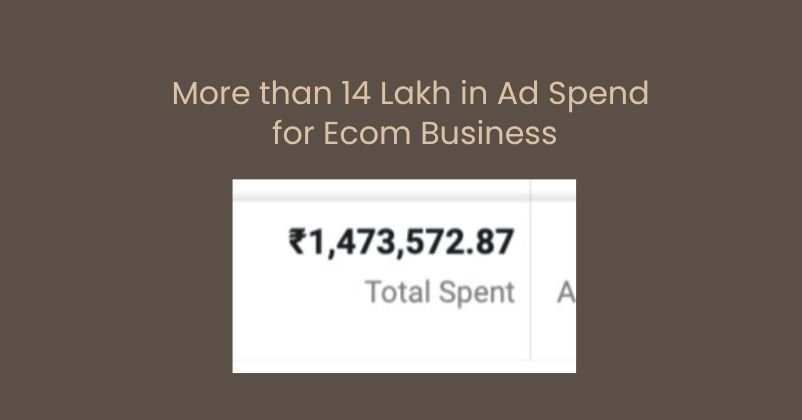
Online Coaching Business – ₹83 Lakh+ in Ad Spend
This high-ticket online coaching business trusted us with an aggressive scaling plan. Over ₹83 lakh was invested in Facebook Ads, driving thousands of qualified leads. The campaigns combined video ads, retargeting, and lookalike audiences to maintain lead quality even at high spend levels.
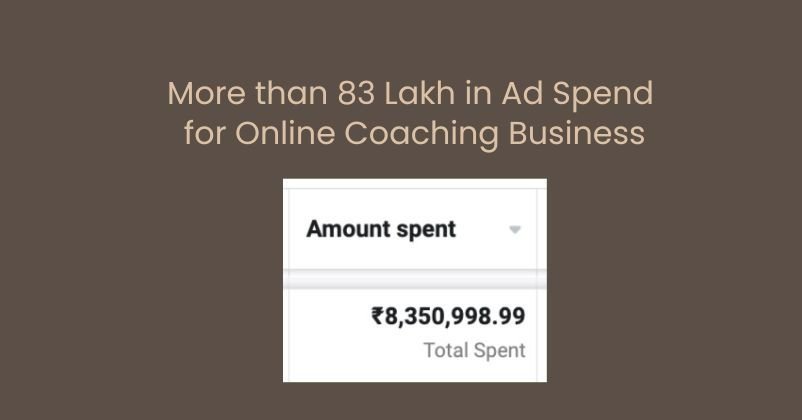
Online Courses Business – ₹13 Lakh+ in Ad Spend
For a course-selling brand, we spent over ₹13 lakh in ads, leveraging creative testing and Advantage+ campaigns. This produced consistent sales month after month while reducing cost per purchase by 27% compared to industry averages.
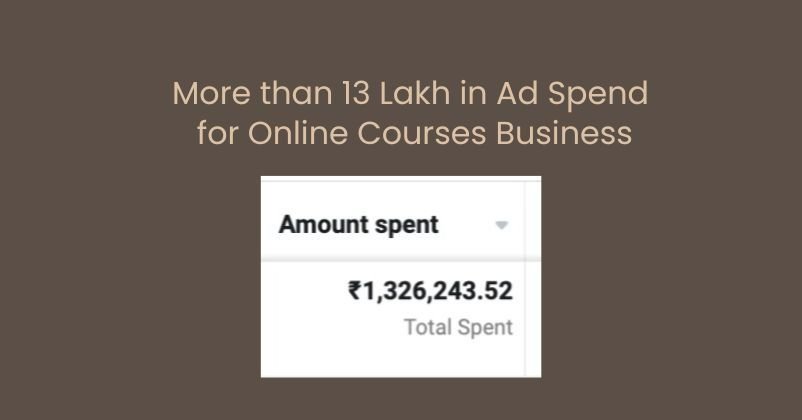
Astrology Business – 5,000 Leads at ₹8 Each
In one of our favourite lead-gen wins, we delivered 5,000 leads for an astrology course business at just ₹8 per lead. This was achieved using high-converting ad creatives, precise interest targeting, and strong follow-up funnels.
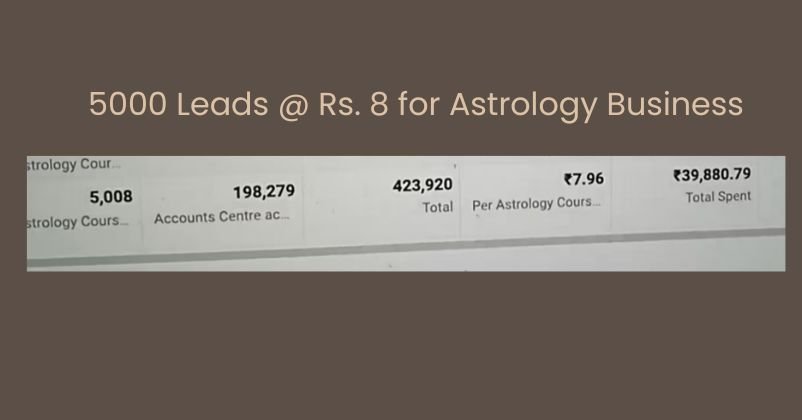
These results prove that with the right approach, Facebook Ads in India can deliver measurable, scalable, and profitable growth — no matter the niche.
Free Resources for Facebook Ads Learners
Learning Facebook Ads in India doesn’t have to be expensive. In fact, the more free, high-quality resources you consume, the faster you’ll get results without burning money on trial and error.
Here are some free guides, tools, and posts from The DM School that will help you become a smarter advertiser:
- How to Make Money in One Hour – A quick-start mindset and execution plan for generating revenue fast.
- Ultimate Instagram Hashtag Guide – Learn how to boost your Instagram reach without spending a Rupee.
- Make Money Online in India – Multiple ways to build income streams using digital marketing skills.
- Make Money from Digital Marketing – Proven models to monetise your skills and run profitable campaigns.
- Course Selling Business – A complete framework for creating, marketing, and scaling online courses.
These resources work best when combined with consistent testing, tracking, and learning inside your own ad account. The more you experiment, the faster you’ll develop instincts that separate amateurs from pros.
Conclusion & Next Steps
Running Facebook Ads in India in 2025 is both an art and a science. The art is in crafting creatives that stop the scroll. The science is in reading your data, optimising campaigns, and scaling winners without breaking them.
If you’ve followed this guide step-by-step — from setting up Business Manager and Pixel to picking the right objective and scaling campaigns — you already know more than 90% of beginners. The next step is simple: take action.
Every day you wait, your competitors are getting more reach, more leads, and more sales. Whether you’re an e-commerce brand, a coach, a service provider, or someone exploring online business ideas in India, Facebook Ads can become your growth engine.
At The DM School, we’ve spent crores in ad budgets, tested thousands of creatives, and generated results across industries — from ₹8 leads to multi-crore scaling campaigns. We know what works in the Indian market, and we can help you get there faster.
Ready to make Facebook Ads your most profitable marketing channel? Book your free strategy call today and let’s build a campaign that delivers results you can brag about.
![Read more about the article Best Facebook Ads Agency in India | 3,504 Purchases at ₹85 CPO [Case Study]](https://thedmschool.com/wp-content/uploads/2025/09/Facebook-Ads-Agency-in-India-Case-Study-.webp)
